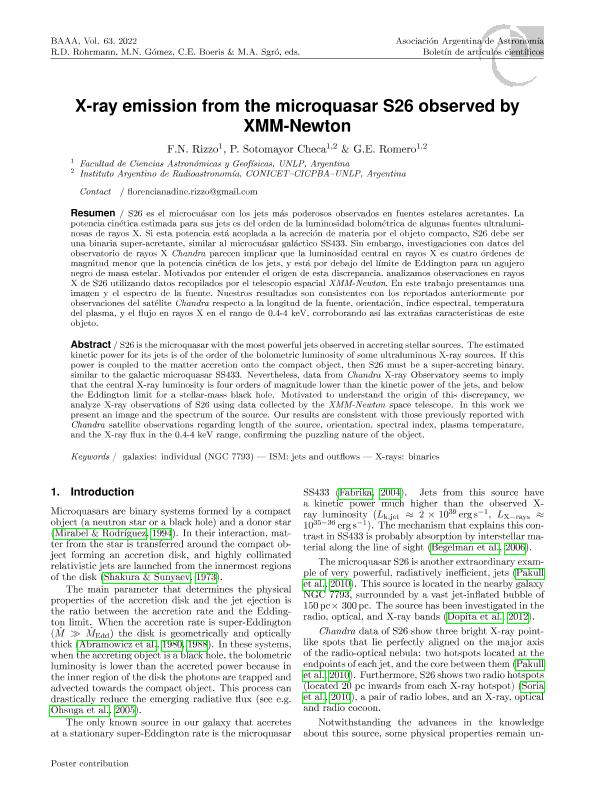Evento
X-ray emission from the microquasar S26 observed by XMM-Newton
Colaboradores:
Rohrmann, Rene Daniel ; Gomez, Mercedes Nieves
; Gomez, Mercedes Nieves ; Boeris, Claudia Evelina
; Boeris, Claudia Evelina ; Sgró, Mario Agustín
; Sgró, Mario Agustín
 ; Gomez, Mercedes Nieves
; Gomez, Mercedes Nieves ; Boeris, Claudia Evelina
; Boeris, Claudia Evelina ; Sgró, Mario Agustín
; Sgró, Mario Agustín
Tipo del evento:
Congreso
Nombre del evento:
Reunion Anual de la Asociación Argentina de Astronomía
Fecha del evento:
25/10/2021
Institución Organizadora:
Universidad Nacional de Córdoba;
Título de la revista:
Boletín de la Asociación Argentina de Astronomía
Editorial:
Asociación Argentina de Astronomía.
ISSN:
0571-3285
e-ISSN:
1669-9521
Idioma:
Inglés
Clasificación temática:
Resumen
S26 is the microquasar with the most powerful jets observed in accreting stellar sources. The estimatedkinetic power for its jets is of the order of the bolometric luminosity of some ultraluminous X-ray sources. If thispower is coupled to the matter accretion onto the compact object, then S26 must be a super-accreting binary,similar to the galactic microquasar SS433. Nevertheless, data from Chandra X-ray Observatory seems to implythat the central X-ray luminosity is four orders of magnitude lower than the kinetic power of the jets, and belowthe Eddington limit for a stellar-mass black hole. Motivated to understand the origin of this discrepancy, weanalyze X-ray observations of S26 using data collected by the XMM-Newton space telescope. In this work wepresent an image and the spectrum of the source. Our results are consistent with those previously reported withChandra satellite observations regarding length of the source, orientation, spectral index, plasma temperature,and the X-ray flux in the 0.4-4 keV range, confirming the puzzling nature of the object.
Archivos asociados
Licencia
Identificadores
Colecciones
Eventos(IAR)
Eventos de INST.ARG.DE RADIOASTRONOMIA (I)
Eventos de INST.ARG.DE RADIOASTRONOMIA (I)
Citación
X-ray emission from the microquasar S26 observed by XMM-Newton; Reunion Anual de la Asociación Argentina de Astronomía; Córdoba; Argentina; 2021; 283-286
Compartir



